C-UAS: Latest Drone Mitigation Technologies
The latest counter unmanned aerial systems (C-UAS) are mature technologies that have been developed to oppose drone attacks ranging from those by individual machines to massive assaults by drone swarms. Mitigation technologies range from kinetic weapons (projectiles) and various jamming measures to lasers. This overview summarizes C-UAS systems that are being deployed, today, to protect municipal buildings, stadiums, airports, universities and commercial businesses.
Recent news reports paint an informative picture of the problem and of relevant C-UAS technologies.
Unarmed hobby-grade drones can be quite dangerous, particularly if struck by aircraft traveling at high speeds. In recent months, owing to such threats, authorities have shut down major airports in London, https://www.citylab.com/transportation/2019/01/airport-flight-delay-heat..., Dubai, https://www.theverge.com/2019/2/15/18226077/dubai-airport-drone-closure-..., and Newark, NJ, https://www.nytimes.com/2019/01/22/nyregion/drones-newark-airport-ground....
Detection
AirWarden by AeroDefense, https://aerodefense.tech/, identifies radio frequency signals to locate the device and pilot—and alerts system operators and other appropriate personnel. The system protects stadiums, correctional facilities, critical infrastructure, and other high value targets. AirWarden has been given the United States Department of Homeland Security (DHS) Developmental Testing and Evaluation (DT&E) Designation under the SAFETY Act. https://i-hls.com/archives/95342?utm_source=Israel+Homeland+Security+%28....
Laser C-UAS Demonstration
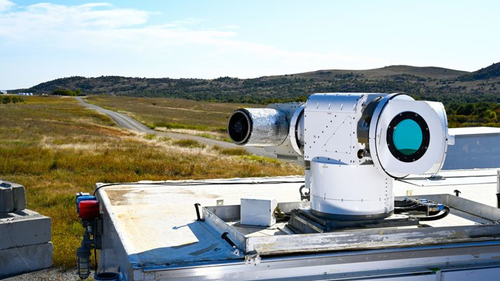
MilitaryAerospace.com, https://www.militaryaerospace.com/unmanned/article/14072287/laser-weapon... reported that a “laser weapons system burned several unmanned aerial vehicles (UAVs) out of the sky at a U.S. Army base in Oklahoma, demonstrating it can handle several threats per engagement.” The Lockheed Martin ATHENA counter UAV system, https://www.defensenews.com/unmanned/2019/11/08/laser-weapon-tracks-and-..., is a 30 kilowatt laser weapon that combines the power of three 10-kilowatt fiber lasers into one 30 kilowatt beam.
3rd Arm Exoskeleton
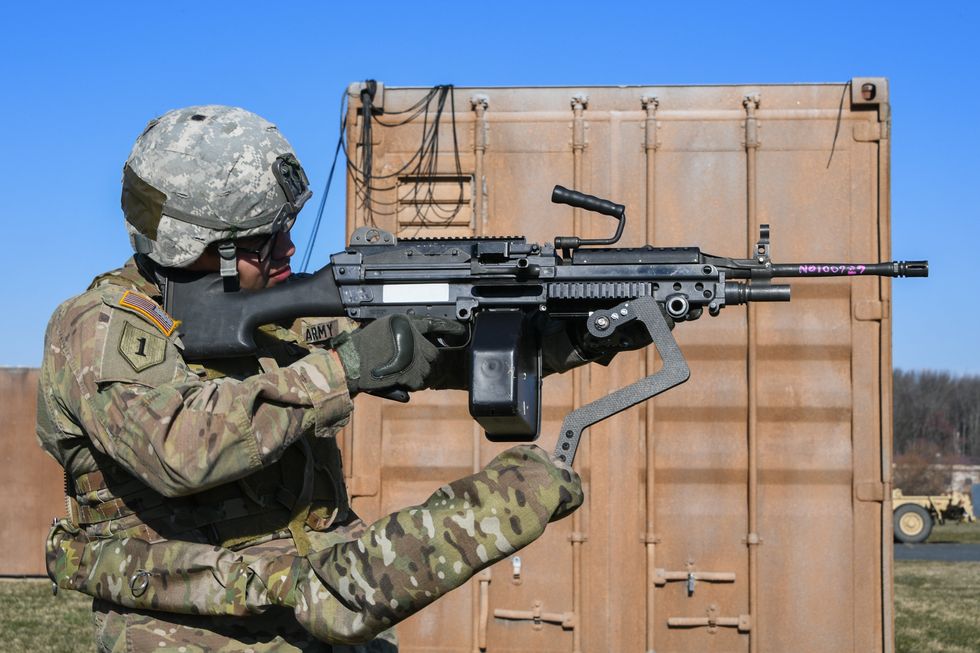 Drone killing systems include man-portable weapons such as the U.S. Army’s prototype “Third Arm exoskeleton.” As reported by Jared Keller in Military Tech, https://taskandpurpose.com/army-third-arm-exoskeleton, Army Sgt. Michael Zamora uses a prototype Third Arm exoskeleton to easily aim an 18-pound M249 light machine gun during testing at Aberdeen Proving Ground, Maryland. …soldiers described the harness as a major boon, reducing fatigue, improving accuracy and boosting overall lethality. The Army further reported, https://taskandpurpose.com/socom-third-arm-counter-drone-system?utm_sour..., that “U.S. special operations forces could eventually deploy with an articulated mechanical 'third arm' that could potentially detect, track, and classify incoming unmanned aerial systems, …SOCOM is working on a mechanical ‘third arm’ that may tout a drone-killing weapon system.”
Drone killing systems include man-portable weapons such as the U.S. Army’s prototype “Third Arm exoskeleton.” As reported by Jared Keller in Military Tech, https://taskandpurpose.com/army-third-arm-exoskeleton, Army Sgt. Michael Zamora uses a prototype Third Arm exoskeleton to easily aim an 18-pound M249 light machine gun during testing at Aberdeen Proving Ground, Maryland. …soldiers described the harness as a major boon, reducing fatigue, improving accuracy and boosting overall lethality. The Army further reported, https://taskandpurpose.com/socom-third-arm-counter-drone-system?utm_sour..., that “U.S. special operations forces could eventually deploy with an articulated mechanical 'third arm' that could potentially detect, track, and classify incoming unmanned aerial systems, …SOCOM is working on a mechanical ‘third arm’ that may tout a drone-killing weapon system.”
Sampling of Leading C-UAS Firms
Leaders in C-UAS manufacturing offer a variety of drone defenses that vary widely in terms of technology, portability, complexity and expense. The following are among the most prominent companies in this growing industry.
Ascent Vision
Ascent Vision, https://ascentvision.com, based in Bozeman, MT, specializes in precision technologies for the unmanned systems industry. Disciplines it specializes in include Counter Drone technology, Aerial Firefighting sensors, airborne ISR, maritime sensors and light weight UAV imaging payloads. It manufactures and distributes worldwide topline gimbal systems. It offers a full-package C-UAS system for fixed site and mobile solutions with its X-MADIS eXpeditionary Mobile Air Defense Integrated System. Technologies used include radar, optics and electronic signal jamming, and these can be deployed by an all-terrain vehicle traveling at 40mph on rough terrain.
Citadel Defense
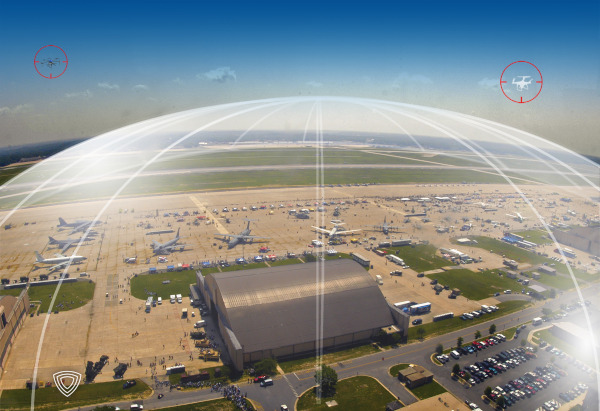
On May 02, 2019 Citadel Defense, https://www.dronecitadel.com, received a U.S. Government award to expand development of their C-UAS technology. LTC(R) Matt England, U.S. Army and now VP of Business Development for Citadel, is quoted on the company’s website: "Our Titan CUAS system autonomously clears the Warfighter's airspace, allowing them to be unconcerned with threat drones and purely focused on the mission at hand..." The Citadel Defense Titan system, which is depicted as a virtual protective dome, detects approaching drones and classifies whether there is a single unit or a swarm, and reports this in real time to its operators, which can be military, governmental or commercial users. The system uses sophisticated electronic countermeasures to induce the drone to land or return to its home base. Enabling technologies include a mix of machine learning algorithms, artificial intelligence and “software defined hardware technology” that rapidly identify airborne intruders before they pose a threat.
Dronebuster
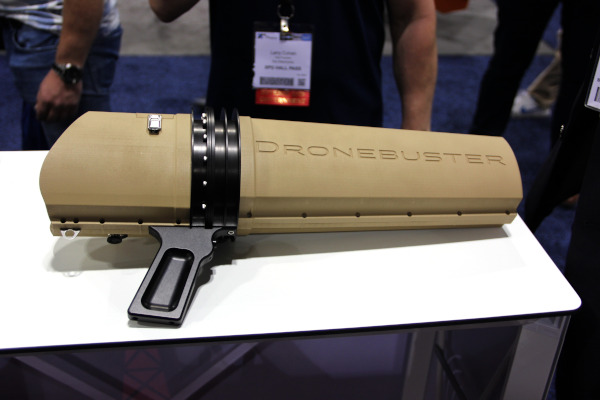
The Dronebuster, http://flexforce.us/counter-uas/dronebuster/, is among several tools fielded by the U.S. Army to counter unmanned aerial systems. Weighing only 5 pounds, it is designed for soldiers at remote locations or on dismounted patrols. Dronebuster’s onboard electronic tools enable a security team to identify and deal with an approaching unmanned aerial system. These tools permit the operator to intercept the drone command link and command the drone to land or return to its home base. The system achieves this by exploiting weaknesses in COTS 915 MHz, 2.45 GHz and 5.8 GHZ comm protocols. It similarly exploits weaknesses in HAM radio 433, 445 and 455 MHz communication protocols to force a landing or return to home. The system also enables operators to identify messages sent by the intruder as video, telemetry or other. The unit can optionally be equipped with GPS disruption capability for jamming GPSL1 and GLONASS L1 frequencies. It is designed for easy updating as new drone technologies emerge.
DroneShield
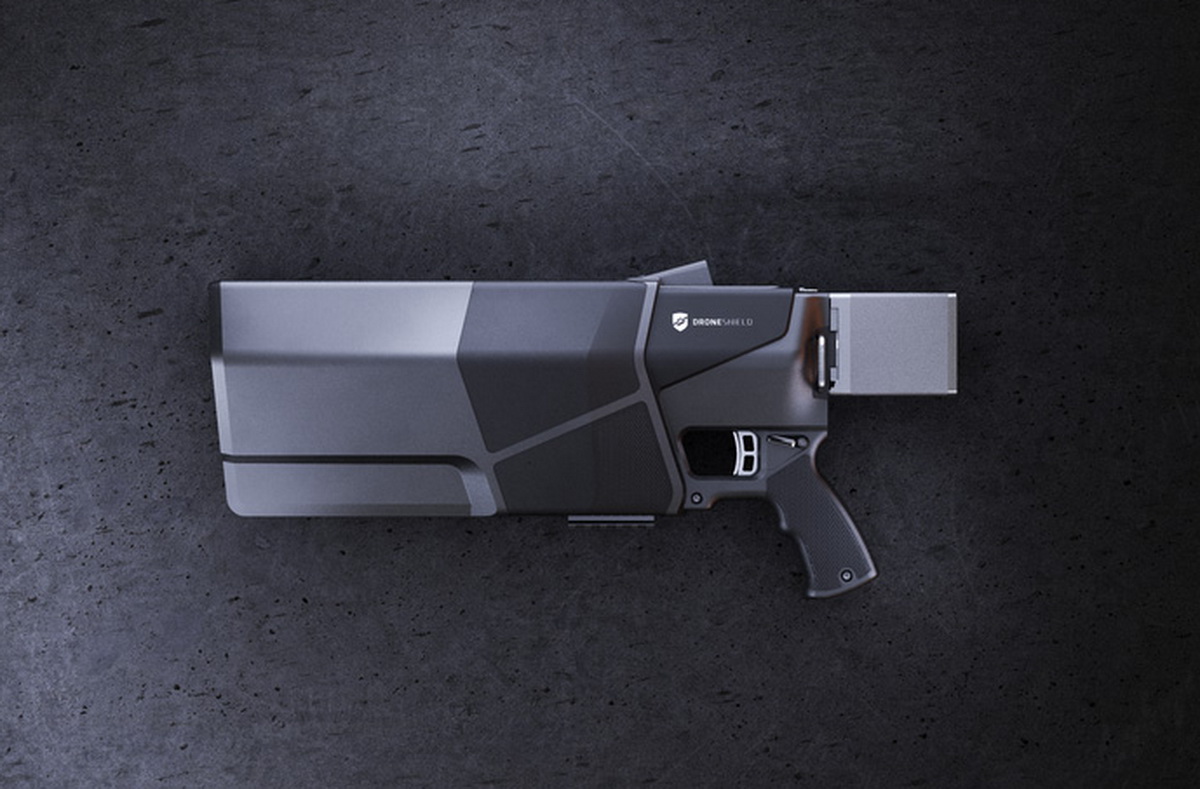
Based in Sydney (Australia), Virginia, Washington DC (USA) and London (UK), DroneShield, https://www.droneshield.com, is a worldwide leader in drone security technology. The Company has developed pre-eminent drone security solutions that protect people, organisations and critical infrastructure from intrusion from drones. Its leadership brings world-class expertise in engineering and physics, combined with deep experience in defence, intelligence, and aerospace... DroneShield provides effective countermeasures to help public and private sector customers take proactive measures against airborne threats to safety, security, and privacy.
DroneShield defines the drone market by dividing it into categories. These distinguish UAS by weight, operating altitude and speed. It also defines threat categories with three elements: nuisance, gathering of intel and delivering contraband or explosives. DroneShield offers a free Counterdrone Handbook on its website, 3rd edition, published August 2019. Their products use sophisticated electronics including a multisensor detection system incorporating radar systems and cameras, and these sensors systems are combined with a jammer to defeat UASs.
Fortem Technologies
%2C 3213pixl_ta.jpg)
Fortem Technologies, https://fortemtech.com, notes that it’s “DroneHunter is the ultimate drone interceptor technology, with over 3500 real-world kills and effective day or night.” It uses onboard TrueView ™ radar that enables autonomous detection, pursuit and NetGun capture of both fixed wing and VTOL drones. The system has the remarkable ability to physically approach an intruder drone at altitude and shoot a net that entraps the intruder, which is then towed to the DroneHunter’s operational base for later forensic analysis.
Invisible Interdiction, Inc.
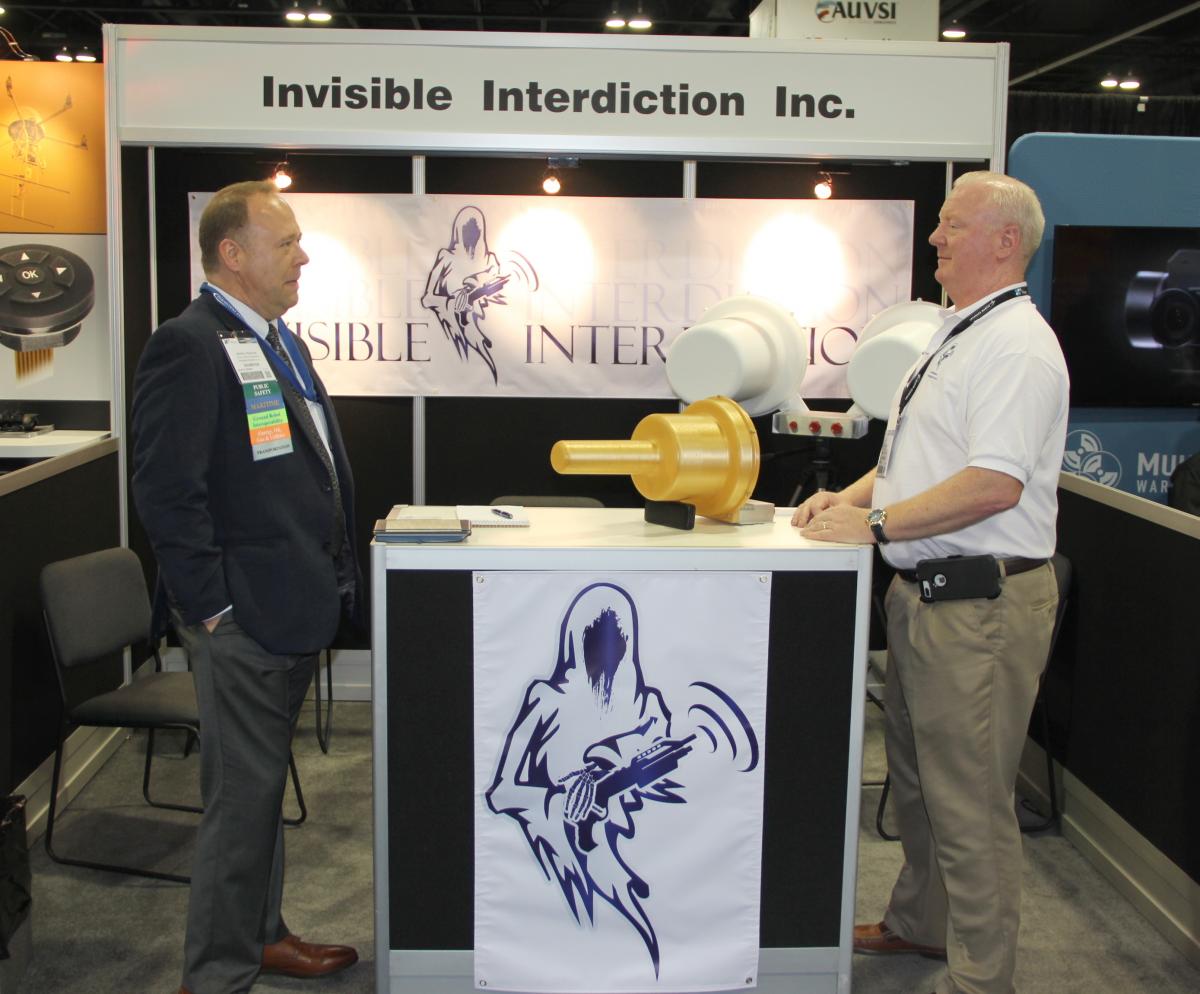
Invisible Interdiction, http://invisidiction.com/, a Florida-based company, was founded in the spring of 2018. The company reports that it offers the lowest power, highest performing C-UAS system on the market. The company specializes in man-portable hand-held systems with full-spectrum electronic jamming capability using known and emerging radio frequency bands. Note that the company represents them to be the smallest and lightest of such systems on the market. Products include hand-held frequency jammers and systems integratable into UAS detection suites using serial, digital and Pelco-D interfaces. Recently awarded a phase-III production contract by the U.S. Airforce, the management team has over five decades of combined experience in the U.S. military.
LITEYE Systems, Inc.
%2C 1152pixl_ta.jpg)
Liteye Systems, Inc., https://liteye.com, is a leading provider of rugged, high-resolution, Helmet Mounted Displays (HMD), Micro Imaging Viewfinders, and Thermal and Radar Surveillance Systems. The company notes that: “Liteye’s AUDS (Anti-UAV Defense System) is a Counter-Drone Defense System that is designed to disrupt and neutralize Unmanned Aerial Vehicles (UAVs), or Unmanned Aircraft Systems (UAS) engaged in hostile airborne surveillance and potentially malicious activity. AUDS is currently deployed with US forces and has numerous confirmed defeats, or kills, of enemy UAS in theatre.”
Liteye's counter unmanned aircraft systems defense technology (“CUAS”) combines electronic-scanning radar target detection, electro-optical (EO) tracking, and classification capability with directional RF inhibition capability. CUAS is a smart-sensor and effector package capable of remotely detecting small UAS and then tracking and classifying one or more intruders before providing the option to disrupt their activity. The company notes its Anti-Drone products may be used in remote or urban areas to prevent UAS being used for terrorist attacks, espionage or other malicious activities against sites with critical infrastructure. CUAS can also serve as a ground surveillance system. Liteye integrates systems and trains operators out of their Colorado facility.
RAYTHEON

Raytheon has not only developed and demonstrated powerful C-UAS laser, C-UAS tube-launched systems, command & control jamming, C-UAS missiles and more, but also has developed a high-powered microwave C-UAS technology that is designed to thwart drone swarms. Raytheon’s PHASER high-powered microwave system, https://www.raytheon.com/news/feature/beam-on, emits radio frequencies in a conical beam from a dish to interdict drone swarms.
SKYDRONER
SkyDroner, http://www.skydroner.com/, is designed to Detect, Distract and Disable any anonymous drone from flying into a protected area. It includes multiple sensors to monitor radio signals and identify the different characteristics of a drone's signature. SkyDroner can distract the drone by taking over command and control frequencies, and it can immobilize the drone, command it to land and/or return to home.
CONCLUSION
Although C-UAS technology has been conceived to a great extent by weapons developers upon whom we depend to protect our national security, the technologies developed, owing to the sheer ubiquity of drones, are being deployed, today, to protect the great expanse of civilian infrastructure—municipal buildings, stadiums, airports, universities, commercial businesses and our major population centers. C-UAS technology ranges from old-fashioned firearms to ultra-modern directed energy weapons, and as it is methodically implemented, it will contribute to a more peaceful and secure future.
BARD College C-UAS Report Update
Please note that in December, 2019, BARD College published an updated comprehensive C-UAS report (see top sidebar for the original 2018 report). The report, https://dronecenter.bard.edu/files/2019/12/CSD-CUAS-2nd-Edition-Web.pdf, notes:
“This second edition of ‘Counter-Drone Systems’ provides background on the growing demand for C-UAS technology, describes how the technology works, presents our database of known C-UAS products from around the globe, and explains some of the challenges surrounding counter-drone technology use.”
Highlights of the 2nd edition:
Number of Products 537
Number of Manufacturers 277
Countries of Origin 38
Systems for Detection Only 175
For Interdiction Only 214
For Detection and Interdiction 138
Story by Tom Atwood. Photo credits: U.S, Army/Conrad Johnson; Lucien Miller, Tom Atwood and cited websites. Copyright © 2019, The National Robotics Education Foundation (NREF)
